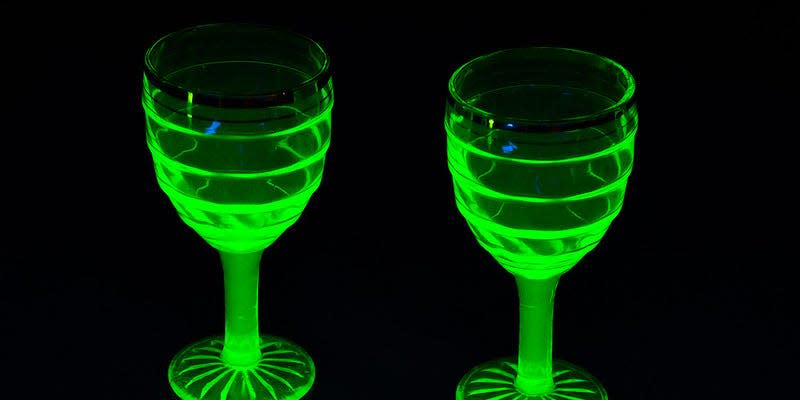Why This Radioactive Uranium Glass Glows Bright Green

"Hearst Magazines and Yahoo may earn commission or revenue on some items through the links below."
Hey y’all, Courtney Linder here, deputy editor at Pop Mech. If you grew up in the 80s or 90s, you probably remember those glow-in-the-dark stars we all used to paste to our ceilings as kids. After turning my bedroom light on for a few minutes, I couldn’t wait to flip the switch and hop into bed to stare up at the glowing green galaxy I’d created. As an adult, my enthusiasm for fluorescent tchotchkes hasn’t gone anywhere; I’ve merely transferred my obsession into collecting antique, radioactive, glow-in-the-dark glassware.
This “uranium glass” originated in Germany in the 1830s and 1840s, says Anne Madarasz, chief historian at the Heinz History Center in Pittsburgh, Pennsylvania, and curator of a longstanding exhibit on glass. Glass was a big business at the time, and to make tableware desirable to consumers, companies were constantly on the hunt for the next intriguing coloring agent.
☢️ Don’t miss any of our radioactive stories. Join Pop Mech Pro.
Enter uranium oxide, an insoluble and thermally stable source of uranium that doesn’t conduct electricity. As an additive in the glassmaking process, it imbues the final product with a transparent yellow or yellowish-green hue. Sometimes, this uranium glass can even appear opaque and colorless. While this greenish-yellow colorway was the trend du jour, it had the unintended and intriguing side effect of glowing bright fluorescent green under ultraviolet (UV) light.
Ultraviolet light is a type of electromagnetic radiation with shorter wavelengths than visible light; it’s the reason why you need to wear sunblock on a hot summer day to avoid a sunburn, since 10 percent of the total electromagnetic radiation from the sun comes in the form of UV rays. Ultraviolet light is also the only fool-proof method for identifying true radioactive uranium glass. According to the Oak Ridge Associated Universities (ORAU) Museum of Radiation and Radioactivity, a black light will cause uranium glass to glow a rich green color. (A small handheld UV flashlight like this one will do the trick).
To be clear, it’s not the uranium oxide’s radioactivity that causes the glass to glow. Rather, it’s the uranium’s chemistry that gives off the eerie slime-colored incandescence. “The uranium fluoresces under UV light because the UV excites the electrons above the ground state and gives off photons as the electrons transition back to the ground state,” Naomi Marks, a research scientist at the Lawrence Livermore National Laboratory in California, tells Collectors Weekly.
Now back to that whole radiation thing. My partner freaked out when I brought home a cardboard box filled with about $100 worth of uranium glass that I bought from a total stranger on Facebook Marketplace back in February. But I assured him the glass wouldn’t harm us—I’d done my research after all. “Most of the tests show the leaching of [uranium] is not substantial,” Madarasz says. “There’s uranium in things like cell phones in our environment. So then we’re being exposed to it from everyday objects at low levels on a constant basis.” Madarasz does have an important caveat, though. Uranium oxide can react with acids, so it’s not a great idea to leave a uranium pitcher of orange juice sitting in your fridge for days.
A 1992 study published in Health Physics backs up Madarasz’s points. It states that the maximum estimated dose of radiation that a person could absorb from uranium glass is on the order of 4 millirems per year, or about 1 to 2 percent of the average American’s annual radiation exposure. And that’s probably a high estimate for everyday people that want to have a glass of wine out of a uranium chalice. Most of the radiation doses would fall on the folks involved in transporting the glassware from the manufacturer to a distribution center.
So how do you get your hands on these beautiful, scientifically fascinating treasures? You can check out Facebook Marketplace like I did or hit your local thrift store. Madarasz says it’s even better to find a local collector’s club in your area, where longtime members can prime you on the antiques and help you find them nearby. Just don’t expect to get rich. ORAU estimates that about 4.16 million pieces of decorative uranium glass were produced in the U.S. between 1958 and 1978 alone. Madarasz says the prices for these collector items fluctuate greatly based on how much people value them at the time.
But don’t let that stop you from picking up a quirky new hobby that can beautify your corner curio cabinet and make a statement, all while piquing your interest in science.
“It’s fun to turn off the lights and see it glow in the dark, and kids love it too,” Madarasz says. “So you know, in terms of people who collect it, I think a lot of people love the fact that they can display it in their homes and it has a wow factor. Something that sets it apart and makes it different.”
You Might Also Like

